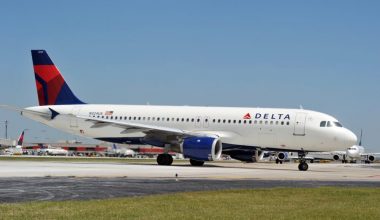The pleasure of flying and celebrating the magical moments in the sky is unbeatable. But planes are intricate machinery, and flying/controlling them isn’t a cup of tea for everyone. Even skilled pilots may encounter unforeseen circumstances while flying that can place the aircraft or its occupants at risk. This calls for an airplane emergency landing, an abnormal touchdown of an aircraft in response to such situations.
In simple terms, an airplane emergency landing is a premature landing made by an airplane in the state of an emergency. A pilot can declare an emergency if it involves an imminent or ongoing threat to the aircraft’s safety and operation. Sometimes, the immediate need for an onboard passenger or crew to end the flight also necessitates an emergency declaration. From an Air Traffic Management (ATM) perspective, it will be called an emergency landing if the pilot-in-command announces an emergency and hasn’t negated it by the time the plane returns to the ground.
Airplane emergency landing is common in fires, engine failures, severe weather conditions, medical emergencies, etc. These cases require quick instinct, rapid response, cognitive thinking, and resilience on the part of pilots. Another important fact is pilots don’t necessarily make an airplane emergency landing on runways. Although the typical procedure is to divert forcibly to the nearest or most suitable airport or bases, pilots don’t always have more time for terrain selection. In such conditions, they can perform landings off the airport in fields, on water surfaces, etc.
Types of emergency landings
There are mainly three different types of airplane emergency landings based on the specific aspects of the event. They are forced landing, precautionary landings, and ditching. Let’s dig into the details of these types of landings.
1. Forced landing
As the name suggests, forced landing is a situation where a pilot must immediately land on or off an airport. It is necessitated by the inability to make continued flight impossible due to factors outside the pilot’s control. Failure of engines, systems, or components, inextinguishable fire or smoke onboard, severe weather, etc., can force an airplane down, necessitating landing as soon as possible. Forced landings occur mainly due to technical problems involving failure or damage to the aircraft’s vital systems (such as engine, hydraulics, and landing gears). Here, it is impossible to continue the further flight, so pilots unavoidably need to land the aircraft, regardless of the terrain.
Read More: All you need to know about World’s most dangerous Airport
In forced landings, a pilot usually deals with an emergency tied to a time-sensitive issue, so he/she is trying to quickly get the aircraft on the ground. The necessity of getting on the ground ASAP is linked to lowering the possibility of injury/death to people aboard.
However, there are situations where a forced landing isn’t considered an emergency because the underlying cause of the event is not serious enough to declare an emergency. The airplane forced to touch down at a different airport following a military obstruction isn’t an emergency landing.
There are also a handful of situations in which the flight crews declare an emergency, but the aircraft is still flyable enough to land at a more suitable airport. The crew may choose to continue the flight to prevent a crash or ditch.
2. Precautionary landing
Another type of airplane emergency landing is a precautionary landing or a premeditated landing on or off an airport. In this type of landing, it is possible to make a further flight but inadvisable due to a hazard with continued flight. Precautionary landing can result from problems within the aircraft, like partial system failure, controllable minor fire, non-extension of landing gear, fuel shortage, etc. Although hazards are commonly technical, they can sometimes be external such as tail strikes, bird strikes, deteriorating weather, etc. Unlike forced landings, a precautionary landing isn’t an absolute necessity but rather a safeguard. It is a planned landing, often made at an aerodrome, in the judgment of the flight crew.
Once the pilot detects something awry, the common practice is to return to their own point of departure and make a precautionary landing. The pilot reports to the air traffic controller (ATC) regarding unanticipated changes during the flight or abnormal situations. In turn, the ATC of the concerned airport facilitates a precautionary landing on a potential site located and inspected by the pilot. The pilot must pay attention to the route selected during preflight planning, height above the ground during the emergency, and excess airspeed when selecting the landing site. The chance of additional limitations being imposed by hazards becomes less upon the pilot’s quick choice of airplane emergency landing site.
Conditions calling for a precautionary landing
The pilot performs precautionary landing to keep passengers and crew safe when an aircraft experiences technical defects. They include communication defects, partial loss of cabin pressure, gradually developing engine trouble, etc. Other than technical issues, there can be medical or police emergencies. In precautionary landings, pilots change their intended flight plan and choose the most appropriate landing site to avoid further risks. The landing is said to be prudent when the aircraft still has the power to continue the flight despite technical or similar defects and pilots choose to touchdown at the nearest suitable aerodrome instead.
Although such problems aren’t serious enough to endanger the flight or declare ‘Mayday,’ the crew undertakes the precautionary landing to avoid unnecessary risks.
Difference between forced landing and precautionary landing
Forced and precautionary landings can be used interchangeably, but there are several differences. Pilots doing forced landings don’t have enough time for terrain selection and the planning of the approach. The crews don’t have a choice of continuing the flight, and the main priority is to land ASAP. On the other hand, crew expediting a precautionary landing have, in fact, options for further flight and can reach the potential landing site beyond gliding distance. Forced landing involves the immediate touchdown of the aircraft regardless of the terrain. In contrast, a precautionary landing is made with power in anticipation of a real emergency and gives some time for pilots to select the terrain.
There’s little room for error in forced landings, while in precautionary landings, pilots can compensate for errors in judgments or techniques using aircraft power. However, too many situations calling for a precautionary landing can result in a forced landing if the crew doesn’t make timely decisions.
Forced landing conditions, such as engine failure, extensive structural damage, etc., are serious enough to endanger the flight. But, precautionary landings are less hazardous and have low fatality rates. Forced landings have a 10% fatality rate, whereas precautionary landings are 0.06% fatal.
3. Ditching
Ditching is another form of airplane emergency landing, forced or precautionary, performed on the water’s surface. It is a controlled emergency landing on the sea, a river, or a lake performed by an airplane when the runway can’t be reached. Ditching an aircraft into water is the last resort when it is impossible to reach a runway or attempt to make an off-airport forced landing fails. Ditching isn’t extremely hazardous and has the worst fatality rate of 20%.
The most successful example of ditching a commercial passenger aircraft into a river is ‘Miracle on the Hudson .’The US Airways Airbus A320 carrying 155 passengers onboard, made the water landing on the Hudson River without any death. The jetliner lost its engine power after a bird strike and made an unpowered ditching with ” one impact, no bounce, and then a gradual deceleration .”Captain Chesley ‘Sully” Sullenberger and co-pilot Jeffrey Skiles made the most successful ditching of a powerless jetliner A320 in aviation history. Despite a few serious injuries, all 150 passengers and five crew made their way out of the Hudson River and survived the accident.
Some incredible airplane emergency landings
Qantas Flight 72: On October 7, 2008, Qantas Airways flight QF72 flying from Singapore Changi to Perth, made an emergency landing at Learmonth Airport due to an in-flight upset caused by a software error resulting in two pitch-downs. The faulty air data inertial reference unit culminated in the aircraft’s sudden, uncommanded pitch-down maneuver. Out of 303 passengers and 12 crew aboard, one crew and 11 passengers suffered severe injuries like fractures, spinal injuries, etc.
Aloha Airlines Flight 243: A scheduled flight AAH243 flying between Hilo and Honolulu on April 28 suffered an explosive decompression in flight caused by metal fatigue and maintenance error. Although the plane landed safely at Kahului Airport, it received extensive structural damage and resulted in one fatality.

British Airways Flight 38: On January 17, 2008, British Airways passenger flight 38, operated by Boeing 777 on the Beijing-London route, encountered restrictions in the fuel supply. As a result, the engine failed to respond to a demand for increased thrust, and the aircraft soon crashed just short of the London-Heathrow runway while landing. All 152 occupants survived the crash, yet 47 of them received injuries.








